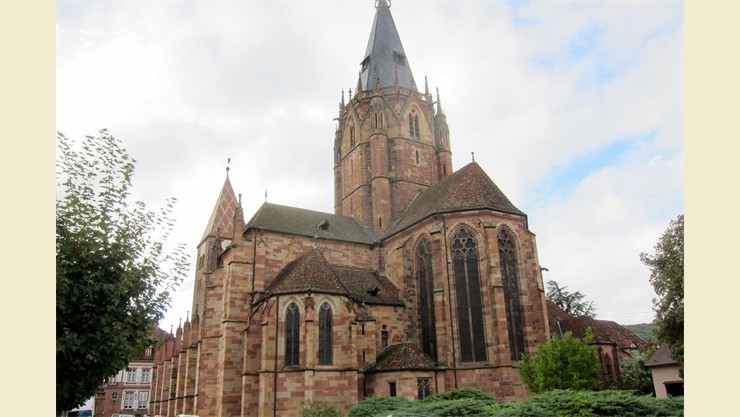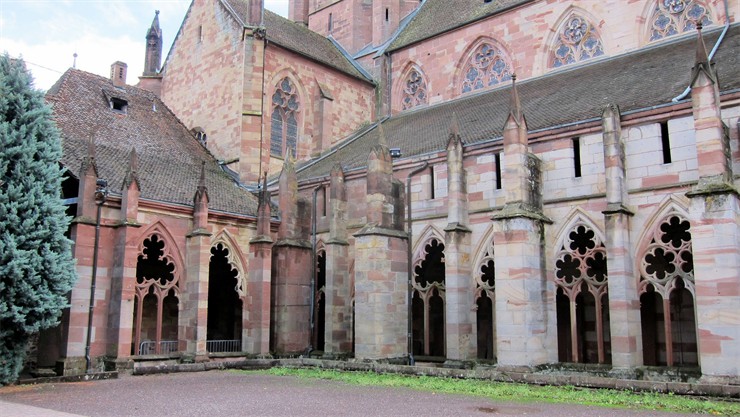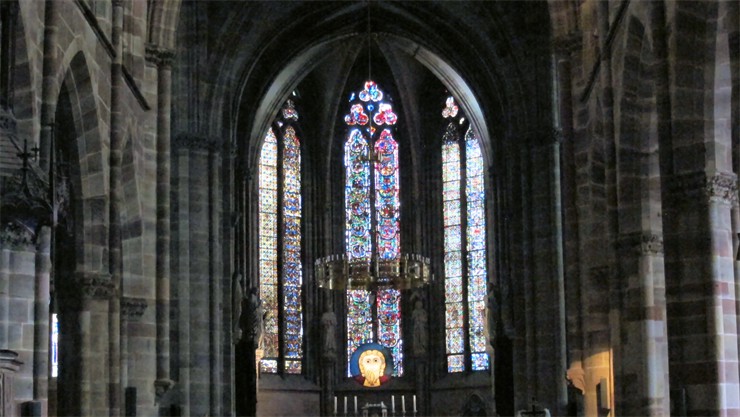
The Benedictine abbey in Wissembourg was founded as early as the 7th century and became the richest abbey in Alsace through donations of land. In 974 the abbey was elevated to imperial status. The monk Otfried of Wissembourg worked here in the 9th century. Otfried wanted to prove with his "Gospel Book", begun in 863 and completed in 871, that artistic poetry was also possible in the vernacular. The work, a rhymed, epic gospel harmony in the South Franconian dialect, describes in five books the life of Jesus on the basis of all four gospels. Otfrid is regarded as the "progenitor of German literature". He introduced the Romanic end rhyme instead of the Germanic staff rhyme. At the Zehntenscheune, Place du Saumon, a relief shows Otfried reading in the Gospels.
The town of Weissenburg developed on the river Lauter from a settlement around the monastery. 1306-1697 it was a free imperial city. It belonged to the Zehnstädtebund of Alsatian imperial cities.
The Romanesque monastery church was built in the 11th century. In the 13th century the church was largely demolished and rebuilt in Gothic style. Only the Romanesque tower has survived. The construction of a cloister was also begun. It is a pity that it was never finished, because what you see is very beautiful.

The serious, frontally depicted head of "Christ of Weissenburg" dates from around 1065 and can now be admired in the Frauenhausmuseum (French Musée de l'Œuvre Notre-Dame) in Strasbourg. It is a fragment of an older window from 1070, one copy of which can be found in the modern stained glass window of the chapter house and another hanging as a picture in the sanctuary (September 2015).
Pictures of the church St. Peter and Paul
-
 seen from the town hall square
seen from the town hall square -

-

-
 with Romanesque tower
with Romanesque tower -
 Rest of the early Romanesque site
Rest of the early Romanesque site -
 Only an unfinished Gothic cloister remains of the old Wissembourg monastery.
Only an unfinished Gothic cloister remains of the old Wissembourg monastery. -

-

-
 was later used as a chapel, today as a room for exhibitions.
was later used as a chapel, today as a room for exhibitions. -
 note the window
note the window -
 It is a copy of the glass window fragment "Christus vom Weissenburg" from the year 1070.
It is a copy of the glass window fragment "Christus vom Weissenburg" from the year 1070. -
 St. Peter und Paul
St. Peter und Paul -
 Stained glass window from the 14th century and a copy of Christ of Wissembourg.
Stained glass window from the 14th century and a copy of Christ of Wissembourg. -
 The organ was restored to its original state in 2010/12.
The organ was restored to its original state in 2010/12. -
 was originally built in 1766 and is the work of organ builder Louis Dubois.
was originally built in 1766 and is the work of organ builder Louis Dubois. -

-
 Detail
Detail -
 Fresco from the 14th century.
Fresco from the 14th century. -
 14. Jhd.
14. Jhd.